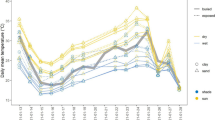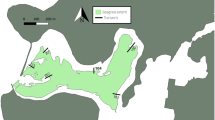Abstract
Freshwater salinization is a growing worldwide threat affecting the structure and functioning of aquatic systems. Increased salinity frequently occurs as result of human activities that determine chronic or, less commonly studied, pulsed contamination of streams and rivers. Here we compared the effects of both patterns of salt addition (i.e. continuous vs. 2 consecutive days/week exposure), within the same ionic concentrations (1, 4 or 6 g l−1 NaCl), on microbial-mediated litter decomposition and associated microbial endpoints. Mass loss of oak leaf litter was consistently depressed by salinization with stronger effects at the highest concentrations, despite the pattern of salt addition. At higher (≥ 4 g l−1) salt concentrations, chronic salt exposure was more deleterious than pulsed inputs to microbial activity, reproductive outputs and fungal richness, despite no effects on fungal biomass. Overall, results suggest that the effective salt concentration to alter fungal activity should be greater in pulsed (vs. chronic) salinization, as intervals between salt pulses seem to facilitate a total or partial recovery of microbial functions. We suggest that, along with the concentration, attention should be devoted to the dynamics of salt contamination when analyzing the consequences of salinization in streams.




Similar content being viewed by others
Data availability
All data generated or analyzed during this study are included in this published article.
References
Abelho, M., 2001. From litterfall to breakdown in streams: a review. The Scientific World Journal 1: 656–680.
Almeida Júnior, E. S., A. Martínez, A. L. Gonçalves & C. Canhoto, 2020. Combined effects of freshwater salinization and leaf traits on litter decomposition. Hydrobiologia 847: 3427–3435.
Arroita, M., L. Flores, A. Larrañaga, E. Chauvet & A. Elosegi, 2018. Hydrological contingency: drying history affects aquatic microbial decomposition. Aquatic Sciences 80: 31.
Cañedo-Argüelles, M., M. Bundschuh, C. Gutiérrez-Cánovas, B. J. Kefford, N. Prat, R. Trobajo & R. B. Schäfer, 2014. Effects of repeated salt pulses on ecosystem structure and functions in a stream mesocosm. Science of the Total Environment 476: 634–642.
Cañedo-Argüelles, M., C. P. Hawkins, B. J. Kefford, R. B. Schäfer, B. J. Dyack, S. Brucet, D. Buchwalter, J. Dunlop, O. Frör, J. Lazorchak, et al., 2016. Saving freshwater from salts. Science 351: 914–916.
Canhoto, C., F. Bärlocher, M. Cañedo-Argüelles, R. Gómez & A. L. Gonçalves, 2021. Salt modulates plant litter decomposition in stream ecosystems. In Swan, C. M. & L. Boyero (eds), The Ecology of Plant Litter Decomposition in Stream Ecosystems Springer, Cham: 323–345.
Canhoto, C., S. Simões, A. L. Gonçalves, L. Guilhermino & F. Bärlocher, 2017. Stream salinization and fungal-mediated leaf decomposition: a microcosm study. Science of the Total Environment 599: 1638–1645.
Castillo, A. M., D. M. T. Sharpe, C. K. Ghalambor & L. F. De León, 2018. Exploring the effects of salinization on trophic diversity in freshwater ecosystems: a quantitative review. Hydrobiologia 807: 1–17.
Clements, W. H. & C. Kotalik, 2016. Effects of major ions on natural benthic communities: an experimental assessment of the US Environmental Protection Agency aquatic life benchmark for conductivity. Freshwater Science 35: 126–138.
da Silva, J. P., A. Martínez, A. L. Gonçalves, F. Bärlocher & C. Canhoto, 2021. Fungal richness does not buffer the effects of streams salinization on litter decomposition. Annales De Limnologie-International Journal of Limnology 57: 5.
Dang, C. K., E. Chauvet & M. O. Gessner, 2005. Magnitude and variability of process rates in fungal diversity-litter decomposition relationships. Ecology Letters 8: 1129–1137.
Entrekin, S. A., N. A. Clay, A. Mogilevski, B. Howard-Parker & M. A. Evans-White, 2019. Multiple riparian-stream connections are predicted to change in response to salinization. Philosophical Transactions of the Royal Society b: Biological Sciences 374: 20180042.
Ferreira, V., B. Castagneyrol, J. Koricheva, V. Gulis, E. Chauvet & M. A. S. Graça, 2015. A meta-analysis of the effects of nutrient enrichment on litter decomposition in streams. Biological Reviews 90: 669–688.
Gessner, M. O. & E. Chauvet, 1993. Ergosterol-to-biomass conversion factors for aquatic hyphomycetes. Applied and Environmental Microbiology 59: 502–507.
Gonçalves, A. L., A. Carvalho, F. Bärlocher & C. Canhoto, 2019. Are fungal strains from salinized streams adapted to salt-rich conditions? Philosophical Transactions of the Royal Society b: Biological Sciences 374: 20180018.
Graça, M. A. S., F. Bärlocher & M. O. Gessner, 2005. Methods to Study Litter Decomposition: A Practical Guide, Springer, Amsterdam.
Gulis, V. & K. Suberkropp, 2003. Leaf litter decomposition and microbial activity in nutrient-enriched and unaltered reaches of a headwater stream. Freshwater Biology 48: 123–134.
Hall, R. O., G. E. Likens & H. M. Malcom, 2001. Trophic basis of invertebrate production in 2 streams at the Hubbard Brook Experimental Forest. Journal of the North American Benthological Society 20: 432–447.
Hieber, M. & M. O. Gessner, 2002. Contribution of stream detrivores, fungi, and bacteria to leaf breakdown based on biomass estimates. Ecology: the Ecological Society of America 83: 1026–1038.
Hintz, W. D. & R. A. Relyea, 2019. A review of the species, community, and ecosystem impacts of road salt salinisation in fresh waters. Freshwater Biology 64: 1081–1097.
Kaiser, C., O. Franklin, U. Dieckmann & A. Richter, 2014. Microbial community dynamics alleviate stoichiometric constraints during litter decay. Ecology Letters 17: 680–690.
Kaspari, M., 2020. The seventh macronutrient: How sodium shortfall ramifies through populations, food webs and ecosystems. Ecology Letters 23: 1153–1168.
Kaushal, S. S., G. E. Likens, M. L. Pace, R. M. Utz, S. Haq, J. Gorman & M. Grese, 2018. Freshwater salinization syndrome on a continental scale. Proceedings of the National Academy of Sciences USA 115: E574–E583.
Kefford, B. J., D. Buchwalter, M. Canedo-Argüelles, J. Davis, R. P. Duncan, A. Hoffmann & R. Thompson, 2016. Salinized rivers: degraded systems or new habitats for salt-tolerant faunas? Biology Letters the Royal Society 12: 20151072.
Marshall, N. A. & P. C. E. Bailey, 2004. Impact of secondary salinisation on freshwater ecosystems: effects of contrasting, experimental, short-term releases of saline wastewater on macroinvertebrates in a lowland stream. Marine and Freshwater Research 55: 509–523.
Martínez, A., J. Barros, A. L. Gonçalves & C. Canhoto, 2020a. Salinisation effects on leaf litter decomposition in fresh waters: does the ionic composition of salt matter? Freshwater Biology 65: 1475–1483.
Martínez, A., A. L. Gonçalves & C. Canhoto, 2020b. Salinization effects on stream biofilm functioning. Hydrobiologia 847: 1453–1459.
Mora-Gómez, J., S. Duarte, F. Cássio, C. Pascoal & A. M. Romaní, 2018. Microbial decomposition is highly sensitive to leaf litter emersion in a permanent temperate stream. Science of the Total Environment 621: 486–496.
Oliveira, R., A. Martínez, A. L. Gonçalves, E. S. A. Júnior & C. Canhoto, 2021. Salt pulses effects on in-stream litter processing and recovery capacity depend on substrata quality. Science of the Total Environment 783: 147013.
R Development Core Team, 2016. R: A language and environment for statistical computing. R Foundation for Statistical Computing, Vienna.
Reis, F., E. Nascimento, H. Castro, C. Canhoto, A. L. Gonçalves, S. Simões, P. García-Palacios, R. Milla, J. P. Sousa & P. M. da Silva, 2018. Land management impacts on the feeding preferences of the woodlouse Porcellio dilatatus (Isopoda: Oniscidea) via changes in plant litter quality. Applied Soil Ecology 132: 45–52.
Sauer, F. G., M. Bundschuh, J. P. Zubrod, R. B. Schäfer, K. Thompson & B. J. Kefford, 2016. Effects of salinity on leaf breakdown: dryland salinity versus salinity from a coalmine. Aquatic Toxicology 177: 425–432.
Schäfer, R. B., M. Bundschuh, D. A. Rouch, E. Szöcs, P. C. von der Ohe, V. Pettigrove, R. Schulz, D. Nugegoda & B. J. Kefford, 2012. Effects of pesticide toxicity, salinity and other environmental variables on selected ecosystem functions in streams and the relevance for ecosystem services. Science of the Total Environment 415: 69–78.
Schnürer, J. & T. Rosswall, 1982. Fluorescein diacetate hydrolysis as a measure of total microbial activity in soil and litter. Applied and Environmental Microbiology 43: 1256–1261.
Sinsabaugh, R. L., M. M. Carreiro & S. Alvarez, 2002. Enzyme and Microbial Dynamics of Litter Decomposition. Enzymes in the Environment, Activity, Ecology, and Applications, Marcel Dekker, New York:, 249–265.
Suárez, M. L., M. M. Sánchez-Montoya, R. Gómez, M. I. Arce, R. Del Campo & M. R. Vidal-Abarca, 2017. Functional response of aquatic invertebrate communities along two natural stress gradients (water salinity and flow intermittence) in Mediterranean streams. Aquatic Sciences 79: 1–12.
Swisher, R. & G. C. Carroll, 1980. Fluorescein diacetate hydrolysis as an estimator of microbial biomass on coniferous needle surfaces. Microbial Ecology 6: 217–226.
Szöcs, E., E. Coring, J. Bäthe & R. B. Schäfer, 2014. Effects of anthropogenic salinization on biological traits and community composition of stream macroinvertebrates. Science of the Total Environment 468: 943–949.
Tank, J. L., E. J. Rosi-Marshall, N. A. Griffiths, S. A. Entrekin & M. L. Stephen, 2010. A review of allochthonous organic matter dynamics and metabolism in streams. Journal of the North American Benthological Society 29: 118–146.
Tiegs, S. D., D. M. Costello, M. W. Isken, G. Woodward, P. B. McIntyre, M. O. Gessner, E. Chauvet, N. A. Griffiths, A. S. Flecker, V. Acuña, et al., 2019. Global patterns and drivers of ecosystem functioning in rivers and riparian zones. Science Advances 5: eaav0486.
Tyree, M., N. Clay, S. Polaskey & S. Entrekin, 2016. Salt in our streams: even small sodium additions can have negative effects on detritivores. Hydrobiologia 775: 109–122.
Velasco, J., C. Gutiérrez-Cánovas, M. Botella-Cruz, D. Sánchez-Fernández, P. Arribas, J. A. Carbonell, A. Millán & S. Pallarés, 2019. Effects of salinity changes on aquatic organisms in a multiple stressor context. Philosophical Transactions of the Royal Society b: Biological Sciences 374: 20180011.
Venâncio, C., B. B. Castro, R. Ribeiro, S. C. Antunes, N. Abrantes, A. Soares & I. Lopes, 2019. Sensitivity of freshwater species under single and multigenerational exposure to seawater intrusion. Philosophical Transactions of the Royal Society b: Biological Sciences 374: 20180252.
Wallace, J. B., S. L. Eggert, J. L. Meyer & J. R. Webster, 1997. Multiple trophic levels of a forest stream linked to terrestrial litter inputs. Science 277: 102–104.
Webster, J. R., 2007. Spiraling down the river continuum: stream ecology and the U-shaped curve. Journal of the North American Benthological Society 26: 375–389.
Acknowledgements
We gratefully acknowledge Prof. Felix Bärlocher for the English revision and helpful comments on the manuscript. This study was supported by a) Project UIDP/04004/2020 co-funded by FCT/MEC through national funds and by FEDER, within the PT2020 Partnership Agreement, and COMPETE 2020; and b) Project ReNATURE — Valorization of the Natural Endogenous Resources of the Centro Region (Centro 2020, Centro-01-0145-FEDER-000007), which also supported AM (fellowship reference ReNATURE – BPD11_2).
Funding
The authors have not disclosed any funding.
Author information
Authors and Affiliations
Contributions
CC and ALG contributed to the study conception and design. Material preparation, data collection and analysis were performed by RO, ALG and AM. The first draft of the manuscript was written by CC and all authors commented on previous versions of the manuscript. All authors read and approved the final manuscript.
Corresponding author
Ethics declarations
Conflict of interest
The authors declare that they have no known competing financial interests or personal relationships that could have appeared to influence the work reported in this paper.
Additional information
Guest editors: Erik Jeppesen, Miguel Cañedo-Argüelles, Sally Entrekin, Judit Padisák & S.S.S. Sarma / Effects of induced changes in salinity on inland and coastal water ecosystems.
Publisher's Note
Springer Nature remains neutral with regard to jurisdictional claims in published maps and institutional affiliations.
Rights and permissions
Springer Nature or its licensor holds exclusive rights to this article under a publishing agreement with the author(s) or other rightsholder(s); author self-archiving of the accepted manuscript version of this article is solely governed by the terms of such publishing agreement and applicable law.
About this article
Cite this article
Canhoto, C., Oliveira, R., Martínez, A. et al. Pulsed vs. chronic salinization effects on microbial-mediated leaf litter decomposition in fresh waters. Hydrobiologia 850, 4547–4556 (2023). https://doi.org/10.1007/s10750-022-04991-w
Received:
Revised:
Accepted:
Published:
Issue Date:
DOI: https://doi.org/10.1007/s10750-022-04991-w




